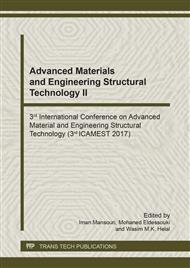p.1
p.8
p.17
p.22
p.27
p.33
p.39
p.44
A Comparative Study of Viscoelastic Boundary Parameters for Bedding Rock
Abstract:
The bedding rock mass is a common geological configuration in earthquake engineering, and the wave method is often used in seismic response analysis, but the accuracy of the analysis is restricted because of the viscoelastic boundary parameters can only be take approximate values. In order to select the most reasonable approximation of boundary parameters in the analysis, in this paper, based on the transversely isotropic constitutive relation of the bedding rock mass, the existing methods of spring coefficients and damping coefficients are compared and analyzed, and the suggestion for the approximate values of the viscoelastic boundary of the bedding rock mass is given.
Info:
Periodical:
Pages:
17-21
Citation:
Online since:
March 2018
Authors:
Price:
Сopyright:
© 2018 Trans Tech Publications Ltd. All Rights Reserved
Share:
Citation:


